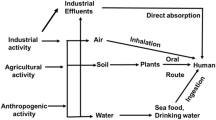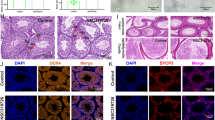Abstract
Dichlorodiphenoxytrichloroethane (DDT), a persistent organic pollutant and hepatotoxicant, is used to control the malaria. However, scarce information exists on relevant effective inhibitors of DDT’ toxicity. The aim of this study was to investigate protective effects of natural antioxidants vitamin C (VC) or/and vitamin E (VE) on p,p′-DDT-induced genotoxicity and hepatotoxicity in human liver cells. p,p′-DDT exposure increased levels of chromatin condensation, comet parameter, micronucleus induction and DPC co-efficient of HL-7702 cells in a dose-dependent manner. Also, an increase in mRNA levels of CYP1A1 as well as CYP3A4, and a decrease in UGT along with GST were observed. Interestingly, supplementation with VC or/and VE prevented p,p′-DDT-caused alterations in DNA damage and phase metabolism gene expressions, and the combination of VC and VE had a more protective effect than VC or VE alone. These findings illustrated that VC or/and VE could be beneficial for the alleviation of p,p′-DDT-incurred toxicity in human liver cells.
Similar content being viewed by others
References
Rogan, W. J. & Chen, A. Health risks and benefits of bis(4-chlorophenyl)-1,1,1-trichloroethane (DDT). The Lancet 366:763–773 (2005).
Organization, W. H. DDT and its derivatives/published under the joint sponsorship of the United Nations Environment Programme and the World Health Organization (1979).
Turusov, V., Rakitsky, V. & Tomatis, L. Dichlorodiphenyltrichloroethane (DDT): ubiquity, persistence, and risks. Environ Health Perspect 110:125 (2002).
Beard, J. DDT and human health. Sci Total Environ 355:78–89 (2006).
Qiu, X. et al. Contribution of dicofol to the current DDT pollution in China. Environ Sci Technol 39:4385–4390 (2005).
Van Dyk, J. C. et al. DDT contamination from indoor residual spraying for malaria control. Sci Total Environ 408:2745–2752 (2010).
Jaeschke, H. et al. Mechanisms of hepatotoxicity. Toxicol Sci 65:166–176 (2002).
Jin, X.-T. et al. Dichlorodiphenyltrichloroethane exposure induces the growth of hepatocellular carcinoma via Wnt/β-catenin pathway. Toxicol Lett 225:158–166 (2014a).
Jin, X. et al. The evaluation of p,p′-DDT exposure on cell adhesion of hepatocellular carcinoma. Toxicology 322:99–108 (2014b).
DeMarini, D.M. Genotoxicity of tobacco smoke and tobacco smoke condensate: a review. Mutat Res Rev Mutat Res 567:447–474 (2004).
Canales-Aguirre, A. et al. Genotoxic effect of chronic exposure to DDT on lymphocytes, oral mucosa and breast cells of female rats. Int J Environ Res Public Health 8:540–553 (2011).
Geric, M. et al. Cytogenetic status of human lymphocytes after exposure to low concentrations of p,p′-DDT, and its metabolites (p,p′-DDE, and p,p′-DDD) in vitro. Chemosphere 87:1288–1294 (2012).
Hovhannisyan, G. G. Fluorescence in situ hybridization in combination with the comet assay and micronucleus test in genetic toxicology. Mol cytogenet 3:17 (2010).
Košir, R., Španinger, K. & Rozman, D. Circadian events in human diseases and in cytochrome P450-related drug metabolism and therapy. IUBMB Life 65:487–496 (2013).
Moon, Y. J., Wang, X. & Morris, M. E. Dietary flavonoids: effects on xenobiotic and carcinogen metabolism. Toxicol In Vitro 20:187–210 (2006).
Brodie, B. B. Pathways of drug metabolism. J Pharm Pharmacol 8:1–17 (1956).
Rendic, S. & Carlo, F. J. D. Human cytochrome P450 enzymes: a status report summarizing their reactions, substrates, inducers, and inhibitors. Drug Metab Rev 29:413–580 (1997).
Kostiainen, R. et al. Liquid chromatography/atmospheric pressure ionization-mass spectrometry in drug metabolism studies. J Mass Spectrom 38:357–372 (2003).
Durak, D. et al. Malathion-induced oxidative stress in human erythrocytes and the protective effect of vitamins C and E in vitro. Environ Toxicol 24:235–242 (2009).
Vatassery, G. Vitamin E and other endogenous antioxidants in the central nervous system. Geriatrics 53:S25–27 (1998).
Heaney, M. L. et al. Vitamin C antagonizes the cytotoxic effects of antineoplastic drugs. Cancer Res 68:8031–8038 (2008).
Kobori, Y. et al. Antioxidant cosupplementation therapy with vitamin C, vitamin E, and coenzyme Q10 in patients with oligoasthenozoospermia. Arch Ital Urol Androl 86:1–4 (2014).
Shen, Y. et al. Dibenzoyl and isoflavonoid glycosides from Sophora flavescens: inhibition of the cytotoxic effect of D-galactosamine on human hepatocyte HL-7702. J Nat Prod 76:2337–2345 (2013).
Bi, S. et al. Fabrication of polystyrene microscale porous substrate and its effects on HL-7702 cells behaviors. J Biomed Mater Res A 102:1518–1526 (2014).
Jin, X. et al. Protective efficacy of vitamins C and E on p,p′-DDT-induced cytotoxicity via the ROS-mediated mitochondrial pathway and NF-κB/FasL pathway. PLoS One 9:e113257 (2014c).
Yanez, L. et al. Levels of dichlorodiphenyltrichloroethane and deltamethrin in humans and environmental samples in malarious areas of Mexico. Environ Res 88:174–181 (2002).
Aneck-Hahn, N. H. et al. Impaired semen quality associated with environmental DDT exposure in young men living in a malaria area in the Limpopo Province, South Africa. J Androl 28:423–434 (2007).
Bratton, M. R. et al. The organochlorine o,p′-DDT plays a role in coactivator-mediated MAPK crosstalk in MCF-7 breast cancer cells. Environ Health Perspect 120:1291–1296 (2012).
Zhao, M. et al. Enantioselective cytotoxicity profile of o,p′-DDT in PC 12 cells. PLoS One 7:e43823 (2012).
Yanez, L. et al. DDT induces DNA damage in blood cells. Studies in vitro and in women chronically exposed to this insecticide. Environ Res 94:18–24 (2004).
Shi, Y. et al. Synergistic genotoxicity caused by low concentration of titanium dioxide nanoparticles and p,p′-DDT in human hepatocytes. Environ Mol Mutagen 51:192–204 (2010).
Perez-Maldonado, I. N. et al. Variability in DDT-induced apoptosis in Mexican indigenous populations. Toxicol Mech Methods 21:675–680 (2011).
Garaj-Vrhovac, V., Gajski, G. & Ravlic, S. Efficacy of HUMN criteria for scoring the micronucleus assay in human lymphocytes exposed to a low concentration of p,p′-DDT. Braz J Med Biol Res 41:473–476 (2008).
Medina-Díaz, I. M. & Elizondo, G. Transcriptional induction of CYP3A4 by o,p′-DDT in HepG2 cells. Toxicol Lett 157:41–47 (2005).
Niimi, S. et al. Identification and hepatic expression profiles of cytochrome P450 1-4 isozymes in common minke whales (Balaenoptera acutorostrata). Comp Biochem Physiol B Biochem Mol Biol 147:667–681 (2007).
Wyde, M. E. et al. The environmental pollutant 1,1-dichloro-2,2-bis(p-chlorophenyl)ethylene induces rat hepatic cytochrome P450 2B and 3A expression through the constitutive androstane receptor and pregnane X receptor. Mol Pharmacol 64:474–481 (2003).
Mulder, G. J. Conjugation reactions in drug metabolism: an integrated approach: CRC Press; (2003).
Rushmore, T. H. & Tony Kong, A. Pharmacogenomics, regulation and signaling pathways of phase I and II drug metabolizing enzymes. Curr Drug Metab 3:481–490 (2002).
Wade, M. G. et al. Thyroid toxicity due to subchronic exposure to a complex mixture of 16 organochlorines, lead, and cadmium. Toxicol Sci 67:207–218 (2002).
Dickerson, R. et al. Modulation of endocrine pathways by 4,4′-DDE in the deer mouse Peromyscus maniculatus. Sci Total Environ 233:97–108 (1990).
Patil, J. A. et al. Effect of vitamin e supplementation on biochemical parameters in pesticides sprayers of grape gardens of Western maharashtra (India). Indian J Clin Biochem 27:134–140 (2012).
Gonzalez, N. V., Soloneski, S. & Larramendy, M. L. Dicamba-induced genotoxicity in Chinese hamster ovary (CHO) cells is prevented by vitamin E. J Hazard Mater 163:337–343 (2009).
Fetoui, H. et al. Toxic effects of lambda-cyhalothrin, a synthetic pyrethroid pesticide, on the rat kidney: Involvement of oxidative stress and protective role of ascorbic acid. Exp Toxicol Pathol 62:593–599 (2010).
Assayed, M. E., Khalaf, A. A. & Salem, H. A. Protective effects of garlic extract and vitamin C against in vivo cypermethrin-induced teratogenic effects in rat offspring. Food Chem Toxicol 48:3153–3158 (2010).
Shokrzadeh, M. et al. Effect of vitamins A, E and C on liver enzyme activity in rats exposed to organophosphate pesticide diazinon. Pak J Biol Sci 15:936–941 (2012).
Han, M. et al. Nitrogen dioxide inhalation induces genotoxicity in rats. Chemosphere 90:2737–2742 (2013).
Fenech, M. et al. HUMN project: detailed description of the scoring criteria for the cytokinesis-block micronucleus assay using isolated human lymphocyte cultures. Mutat Res 534:65–75 (2003).
Barros, S. B. et al. Dose-dependent study of liver lipid peroxidation related parameters in rats treated with pp′-DDT [J]. Toxicol Lett 70:33–38 (1994).
Mrema, E. J. et al. Persistent organochlorinated pesticides and mechanisms of their toxicity [J]. Toxicology 307:74–88 (2013).
Hoda, Q. & Sinha, S. Vitamin C-mediated minimisation of Rogor-induced genotoxicity. Mutat Res/Genetic Toxicol 299:29–36 (1993).
Castillo, J. et al. Antioxidant activity and radioprotective effects against chromosomal damage induced in vivo by X-rays of flavan-3-ols (Procyanidins) from grape seeds (Vitis vinifera): comparative study versus other phenolic and organic compounds. J Agric Food Chem 48:1738–1745 (2000).
Author information
Authors and Affiliations
Corresponding author
Rights and permissions
About this article
Cite this article
Jin, X.T., Song, L., Liu, X.Y. et al. Protective effects of vitamins C and E on dichlorodiphenyltrichloroethane-induced genotoxicity and hepatotoxicity in human liver cells. Mol. Cell. Toxicol. 13, 155–164 (2017). https://doi.org/10.1007/s13273-017-0016-7
Received:
Accepted:
Published:
Issue Date:
DOI: https://doi.org/10.1007/s13273-017-0016-7




